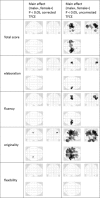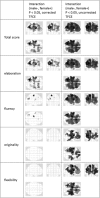Creative females have larger white matter structures: Evidence from a large sample study
- PMID: 27647672
- PMCID: PMC6866835
- DOI: 10.1002/hbm.23369
Creative females have larger white matter structures: Evidence from a large sample study
Abstract
The importance of brain connectivity for creativity has been theoretically suggested and empirically demonstrated. Studies have shown sex differences in creativity measured by divergent thinking (CMDT) as well as sex differences in the structural correlates of CMDT. However, the relationships between regional white matter volume (rWMV) and CMDT and associated sex differences have never been directly investigated. In addition, structural studies have shown poor replicability and inaccuracy of multiple comparisons over the whole brain. To address these issues, we used the data from a large sample of healthy young adults (776 males and 560 females; mean age: 20.8 years, SD = 0.8). We investigated the relationship between CMDT and WMV using the newest version of voxel-based morphometry (VBM). We corrected for multiple comparisons over whole brain using the permutation-based method, which is known to be quite accurate and robust. Significant positive correlations between rWMV and CMDT scores were observed in widespread areas below the neocortex specifically in females. These associations with CMDT were not observed in analyses of fractional anisotropy using diffusion tensor imaging. Using rigorous methods, our findings further supported the importance of brain connectivity for creativity as well as its female-specific association. Hum Brain Mapp 38:414-430, 2017. © 2016 Wiley Periodicals, Inc.
Keywords: creativity; sex difference; structural connectivity; voxel-based morphometry; white matter.
© 2016 Wiley Periodicals, Inc.
Figures



References
-
- Abraham A (2016): Gender and creativity: An overview of psychological and neuroscientific literature. Brain Imaging Behav 10:609–618. - PubMed
-
- Abraham A, Thybusch K, Pieritz K, Hermann C (2014): Gender differences in creative thinking: Behavioral and fMRI findings. Brain Imaging nd Behav 8:39–51. - PubMed
-
- Ashburner J, Friston KJ (2000): Voxel‐based morphometry‐the methods. Neuroimage 11:805–821. - PubMed
-
- Baer J, Kaufman JC (2008): Gender differences in creativity. J Creat Behav 42:75–105.
-
- Baldo JV, Shimamura AP, Delis DC, Kramer J, Kaplan E (2001): Verbal and design fluency in patients with frontal lobe lesions. J Int Neuropsychol Soc 7:586–596. - PubMed
Publication types
MeSH terms
LinkOut - more resources
Full Text Sources
Other Literature Sources

